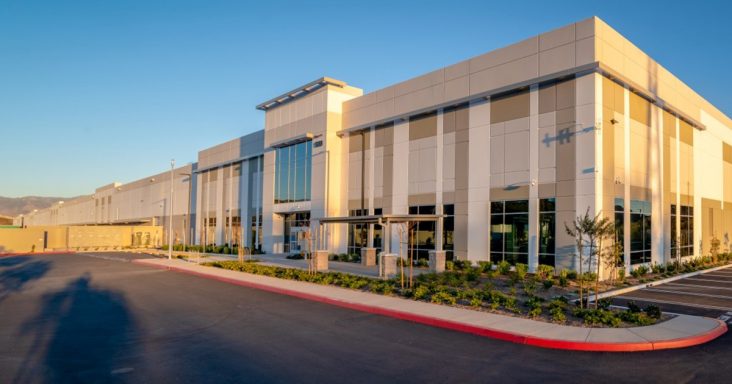Walmart’s new consolidation center aimed at supply chain efficiency
by January 16, 2019 1:44 pm 2,067 views

The new Walmart consolidation center in Colton, Calif., is expected to open in July and will increase the speed and efficiencies with Walmart’s supply chain.
Walmart announced this week its new high-tech consolidation center under construction in Colton, Calif., is slated to come online in July. The 340,000-square-foot facility will be the first in Walmart’s vast supply chain network that’s able to receive, sort and ship freight out to the retailer’s other 42 regional distribution centers.
This automated technology will enable three times more volume throughout the center and will help with supply chain efficiencies for those who ship products using LTL (less than full-truckload) carriers, Walmart said. This new center should also help more suppliers come into compliance with the retailer’s On-Time-In-Full (OTIF) requirements designed to help Walmart’s on-shelf availability across its 4,500 U.S. stores.
Walmart’s supply chain now uses 11 third-party consolidation centers known as CenterPoint, which are located throughout the U.S. The facilities mostly consist of of cross dock terminals that take products shipped LTL and bundle them into full-truckloads for better efficiencies as Walmart likes to move products in full-truckload because it is less expensive. The freight coming from the consolidation centers is routed to Walmart’s 42 distribution centers, which then concentrate on moving the items to the stores.
The role of the consolidation centers are important to keep shelves stocked and the supply chain running efficiently. Walmart gave the following example to illustrate the role of the consolidation center to the overall supply chain.
“Let’s say there are 10 place settings on a dinner table with plates, silverware and glasses, and it’s time to clean up,” Walmart explained in a news release. “If one plate is grabbed at a time, it will take 10 trips to set them all in the sink. But, if you stack the plates, cups and silverware, it only takes a couple of trips. This simple effort to consolidate makes cleaning Sunday dinner much easier.”
Walmart said that’s exactly what consolidation centers do, but the process has been manual up to this point. Merchandise suppliers create and ship 42 separate orders through the same consolidation center, then forward the orders on to each of the 42 regional distribution centers where they are officially received and counted. This makes reacting to order inaccuracies a challenge, because associates may not discover them until the orders are planned to be at the store, Walmart said.
“If Walmart ordered toothpaste, and the request was accidentally fulfilled with mouthwash, Walmart won’t know until the product reaches the regional distribution centers. This means a customer looking for specific toothpaste brands or flavors will experience out of stocks for several shopping trips,” said Geno Bell, senior director of the consolidation center network for Walmart.
When the new center is open, more automation will take place allowing for more transparency up the supply chain. Bell said the new system enables suppliers to fill one massive order instead of 42. The new software will automatically scan and count the product as it arrives at the consolidation center. That information will be documented into Walmart’s systems so the retailer can react faster to replenishment issues.
Bell said making 42 separate orders was also cumbersome for suppliers to sort and keep track of throughout the shipment process.
“Most of the time, they ship the orders as soon as they are ready, which can result in trucks that are not full delivering products,” Bell said “This additional work adds shipping cost to the products. It also means additional trucks on the road, resulting in more carbon emissions and traffic. The technology at Colton solves these problems and creates savings we can pass on to the customer in the form of lower prices.”
Because there will be more transparency upstream, Walmart said this will allow for workers to group products based on how they are stocked, making unloading simpler.
“We’re going to make the regional distribution centers more efficient,” Bell said.
He explained the new center is also a warehouse and it will have the ability to react quicker to unexpected events relating to weather events. For instance, if there is a blizzard in the Northeast there could be a greater need for space heaters. If the extra supply is in Minnesota, it could be harder to get them to Boston. Bell said the new center in California will allow for quicker action and could get the heaters to Boston ahead of the storm.
“With this new technology, we can be surgical and responsive in getting merchandise into stores,” Bell said.
Supply chain experts applaud Walmart’s efforts to deal with the sluggish issues around the CenterPoint distribution network. Walmart outlined its OTIF guidelines to suppliers in 2016 and updated suppliers in early 2018 at the company’s Supplier Growth Forum in Bentonville.
Suppliers were told the new threshold for OTIF deliveries for full truckload shipments is moving from 75% to 85% by April 2018. Less-than-truckload shipments will have a 50% threshold for compliance, up from a 33% baseline set a year ago. The must-arrive-by-date (MABD) window for delivery has moved from to one or two days from four previously.
Walmart said in late 2017 those suppliers using the consolidation network and shipping LTL were having a much harder time reaching the 50% threshold for compliance. Suppliers able to use the new center in California should have an easier time being in compliance.
Walmart has not said if it will continue to use all of the 11 CenterPoint consolidation facilities once the new Walmart high-tech center is open this summer. Suppliers are expected to get an update on the OTIF and the new consolidation center at the upcoming Supplier Growth Forum in Bentonville on Feb. 26-27.
Walmart said the new consolation center will employ 150 to start, with the hope of ramping up to more than 600 by 2021.
